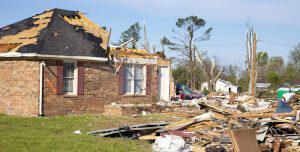How to respond to the deluge of property and casualty claims following a major storm
minutes

When catastrophic weather hits, insurers must prepare for the flood of claims
By all accounts, natural catastrophes in the U.S. created the largest-ever insurance industry losses in 2017. According to London-based Jardine Lloyd Thompson Group P.L.C., the total is expected to exceed $140 billion. In Florida alone, estimates of damages from Hurricane Irma have ranged from $25 to $65 billion. In the immediate aftermath of the storm, 13 million residents were without electricity, according to an article in Insurance Journal.
In the aftermath of any storm, insurers handle a deluge of calls and claims. In catastrophic weather, customer demand spikes massively, often beyond what insurers’ contact centers can handle.
Spikes in claims activity aren’t limited to the worst of the catastrophic events. After a storm passed through Iowa and Nebraska in June of 2017, local insurance agents estimated 10,000 claims had been filed due to damage.
Catastrophic events sometimes prevent insurers from delivering service to people whose lives and property are imperiled. It’s a double-whammy during CAT events—customer service needs go up, while contact center capacity goes down—leading to a poor customer experience.
A 2017 KPMG survey of more than 300 senior insurance executives found that a significant risk insurers face in connection with hurricanes is a “lack of claim-handling personnel,” and following the 2017 hurricanes, the number of additional adjusters needed was “in the thousands.”
A significant problem insurers face after hurricanes is a lack of claim-handling personnel. Following the 2017 hurricanes, thousands of additional adjusters were needed.Fortunately, there’s a customer service model that can flex to adjust to insurers’ constantly changing demands. It offers on-demand skilled agents with relevant insurance experience in property and casualty to guide policy holders through benefit coverage, claims, and first notice of loss (FNOL).
Unfortunately, catastrophic weather is likely to increase in the future. “Expectation remains that global weather patterns will remain in a heightened state of volatility compared to historical norms,” according to the report by Jardine Lloyd Thompson Group. This is why customer service providers—not just those providing support for people filing property and casualty claims—need a plan to handle future events.
Everyone knows that lengthy hold times impact customer experience, especially during the sort of crisis caused by catastrophic weather. “The impact on the agency’s resources and assets by each of the probable disaster scenarios must be analyzed,” Bill Schoeffler and Catherine Oak wrote in an article in Insurance Journal, Disaster Planning for Agencies: Minding Your Business.
Key in a disaster response plan for any contact center should be a partnership with a vendor, such as Liveops, that allows for flexibility to ramp up many more agents. Prepare both your calling platform and your access to agents to adapt seamlessly, correlating workforce needs with changing customer demands.
Liveops has hundreds of skilled agents experienced in providing customer service for property and casualty insurance. Agents are dispersed throughout the country, working from their home offices. By partnering with Liveops, companies can eliminate the threat that natural disasters pose to local contact centers.
During the 2017 California wildfires, “Many insurance agencies in Napa and Sonoma Counties were without power for almost a week,” according to Schoeffler and Oak. “What can the agency do if the office is shut down and the producers and staff cannot access the files or answer the phones? In the case of the wildfires, back-up generators had to be brought in and because of evacuations, some offices could not be accessed at all.”

Elsewhere, insurers and their agents were in the heart of locations hit hard by storms. For instance, an Atlanta-based contact center operator scrambled to find 500 new employees to help handle calls for aid from people affected by Hurricane Harvey, according to an article in the Atlanta Journal-Constitution.
If those agencies had Liveops as a partner, customer service could have continued as usual. The ability to source beyond the local limits of a brick-and-mortar contact center to reach agents that are ready to take calls in any U.S. region can provide peace of mind for both property/casualty insurers and their customers.
Insurers must develop a plan for managing through catastrophic weather events that allows them to dynamically scale operations according to the peaks in demand that may occur. Clearly, a sound way to do that would be to create a real-time workforce to answer the phone quickly and provide empathetic expertise to get policyholders through a tough situation.
Don’t burden policyholders with poor customer service because your contact centers weren’t prepared to handle peaks in demand during a catastrophic weather event. Reach out to us to learn more about how Liveops can power your bottom line with experienced agents. Read more about improving customer service flexibility in our white paper, or how to handle customer service spikes with our webinar.




